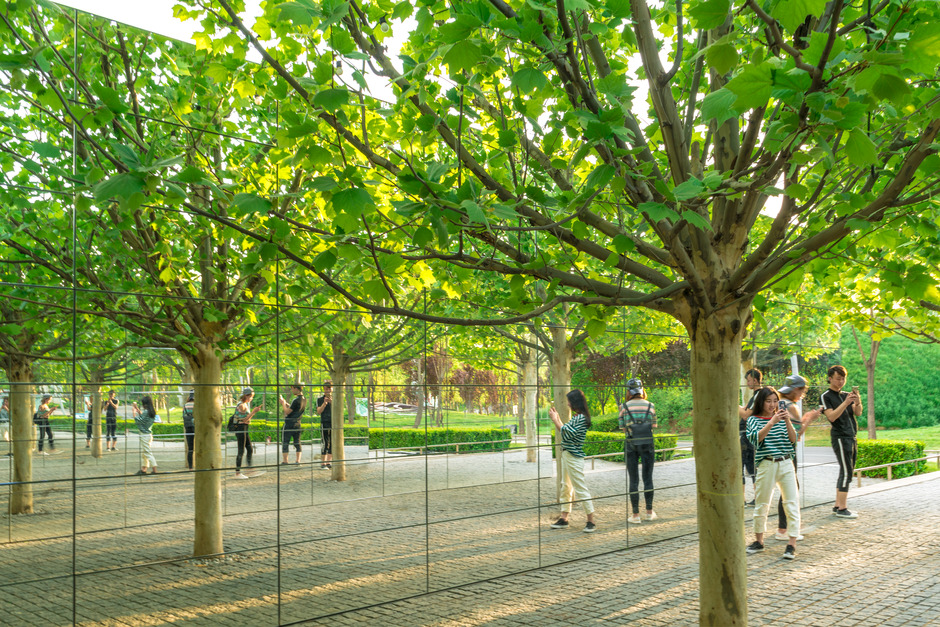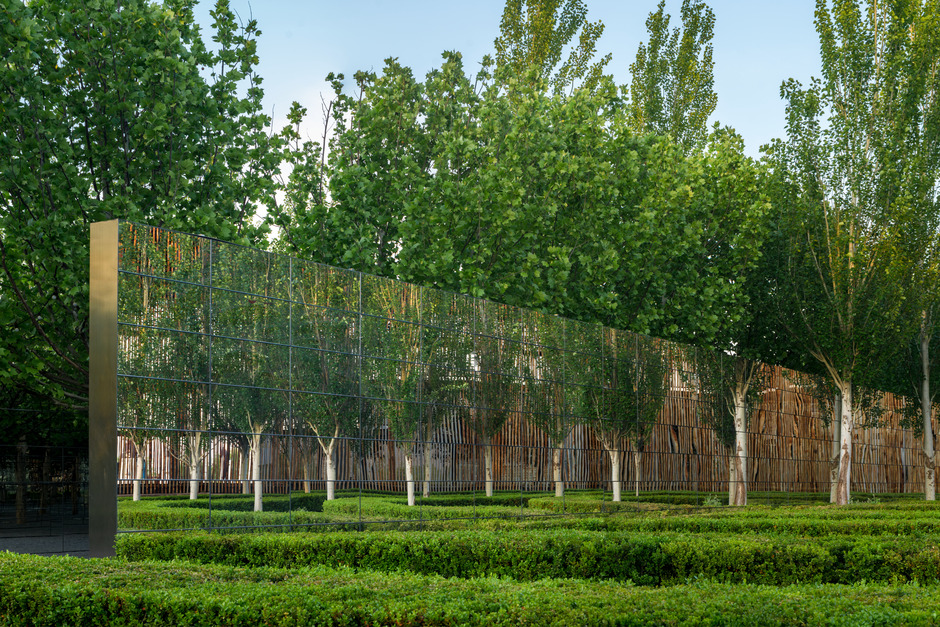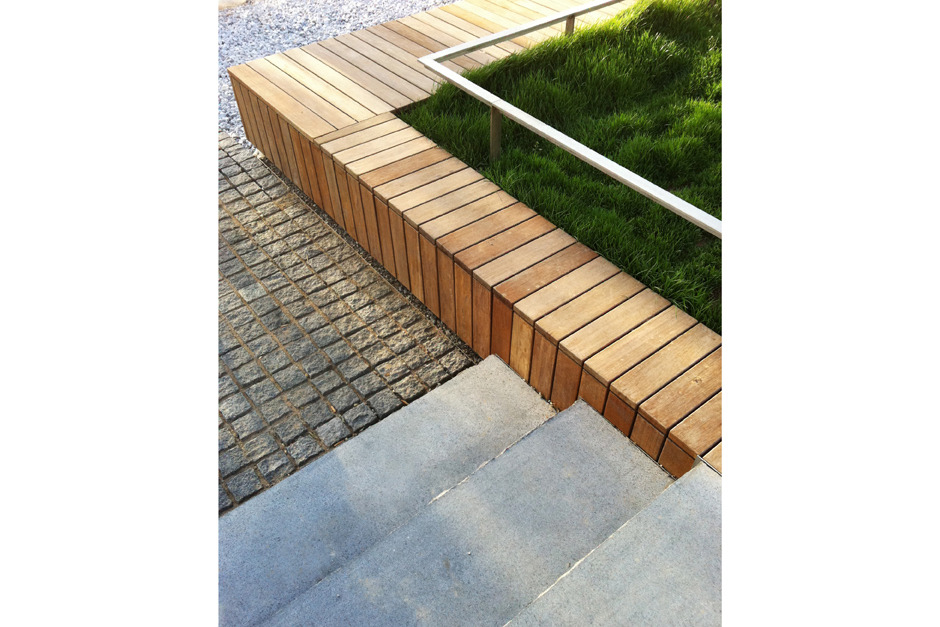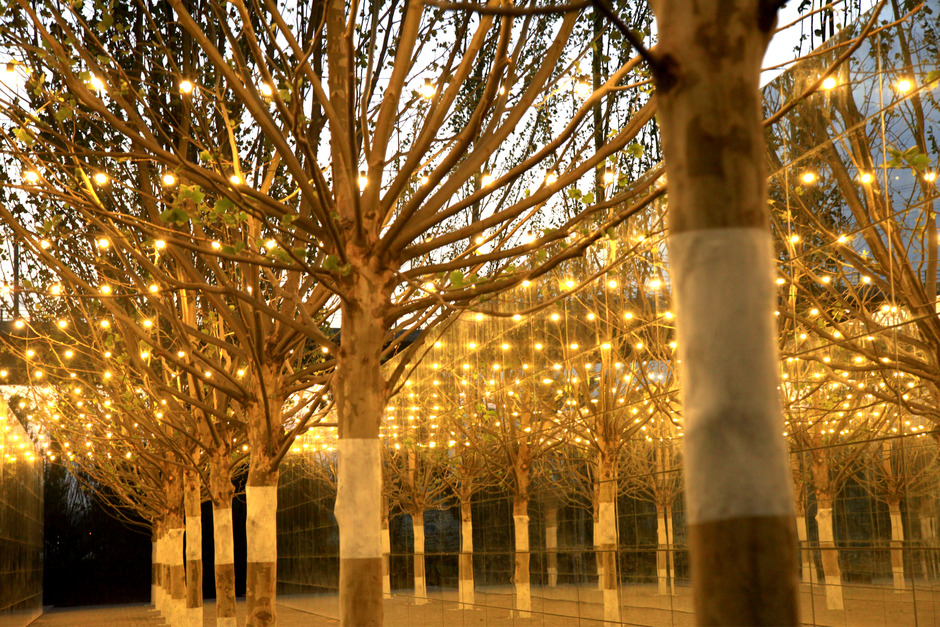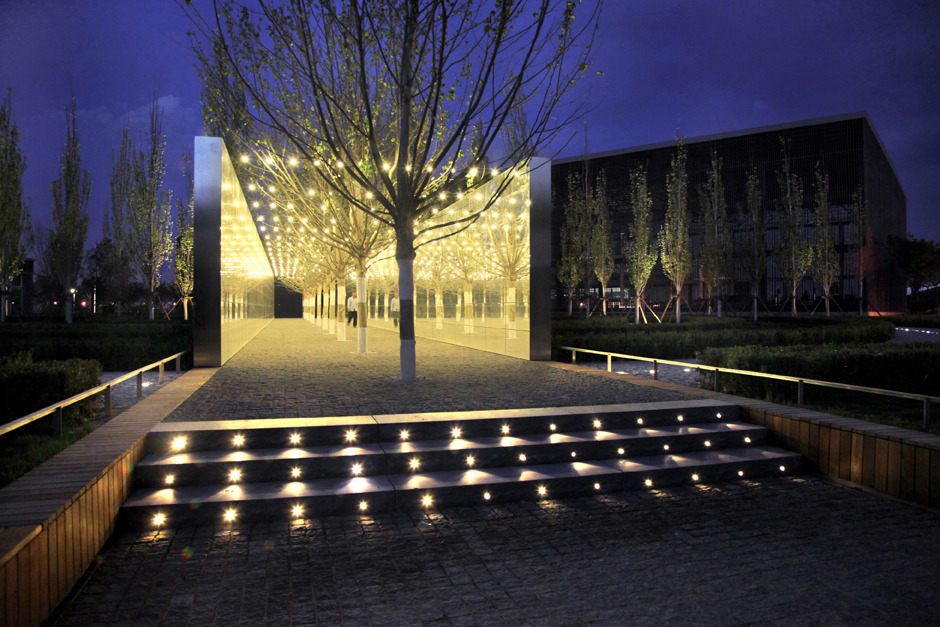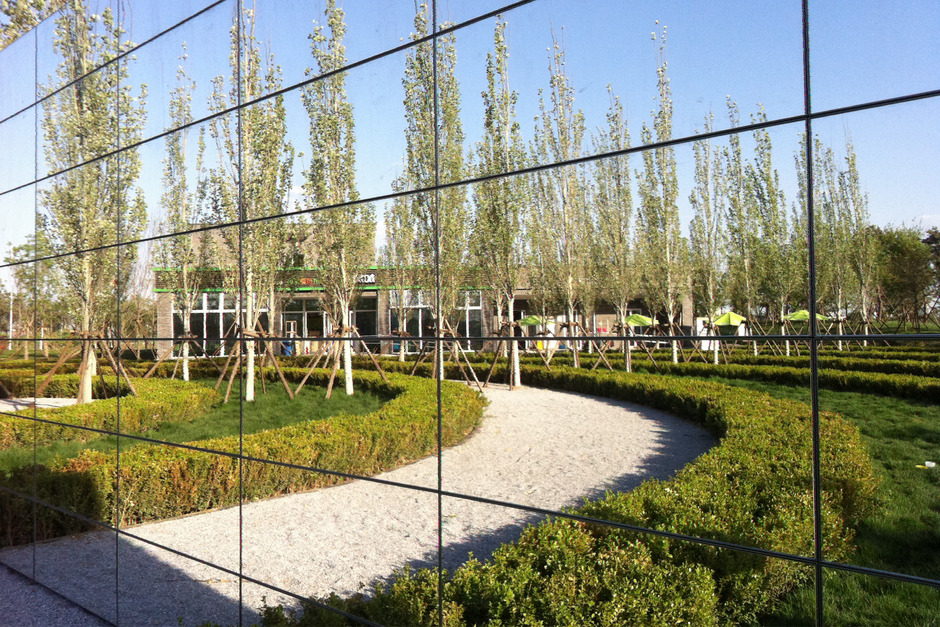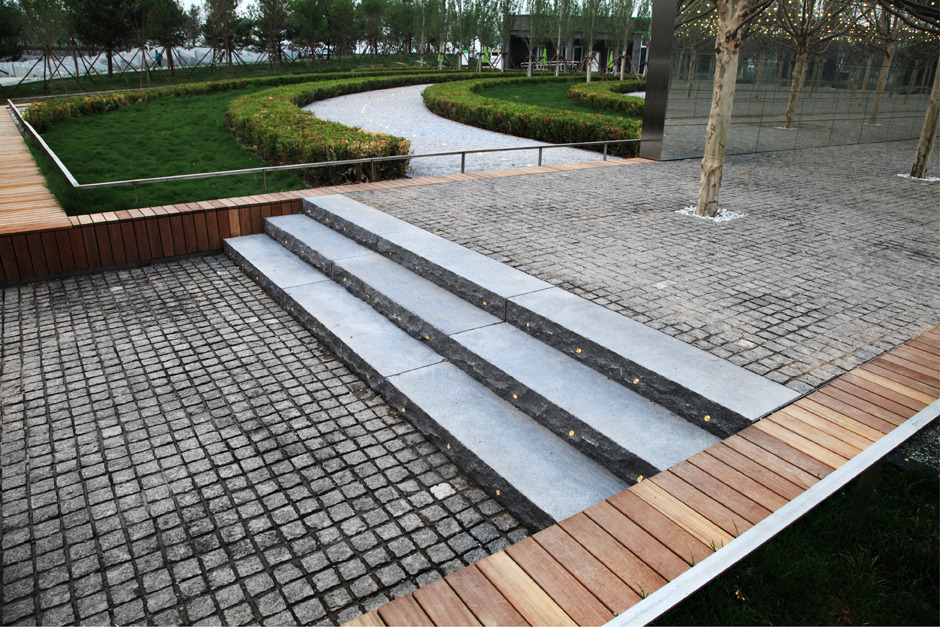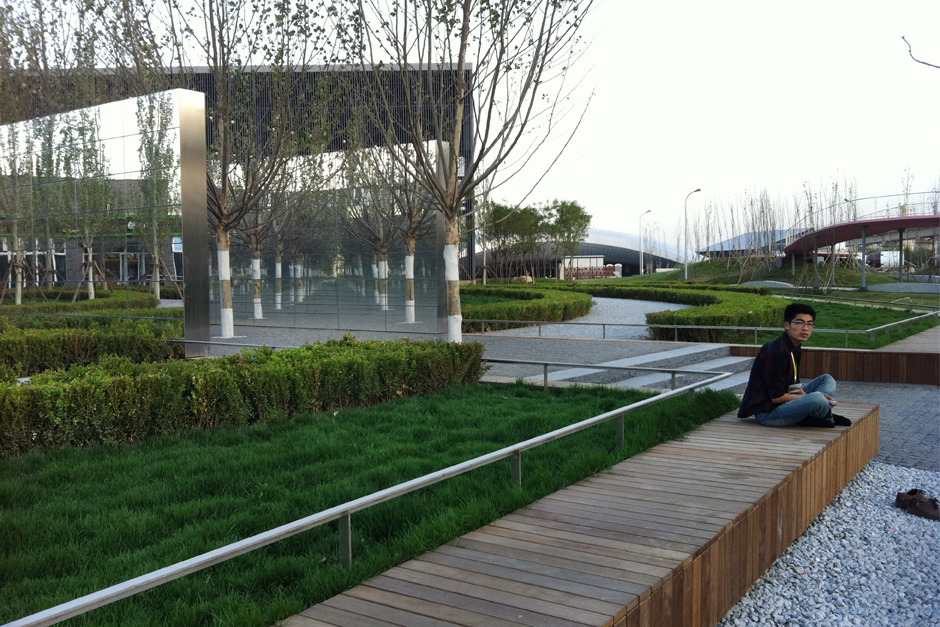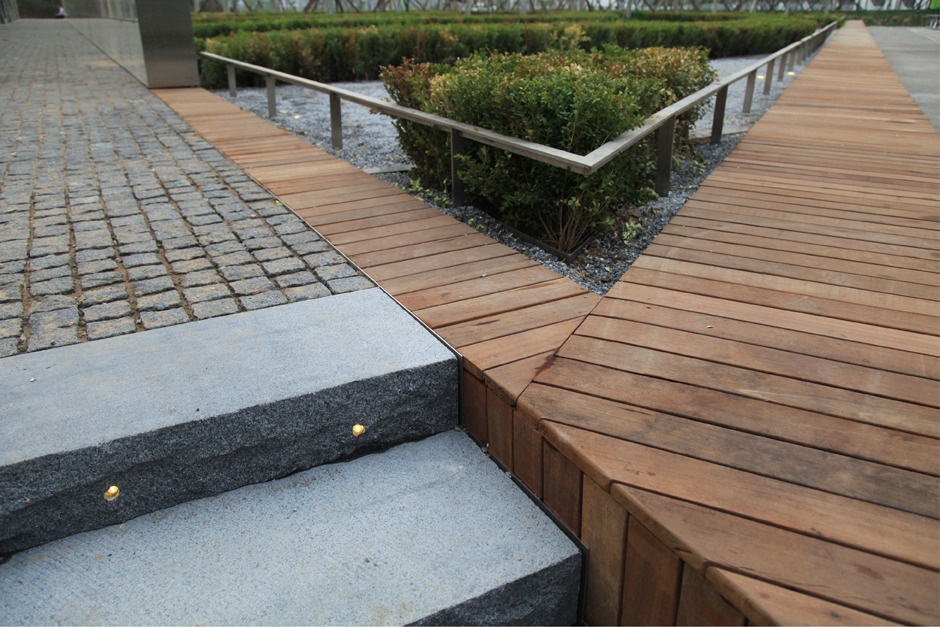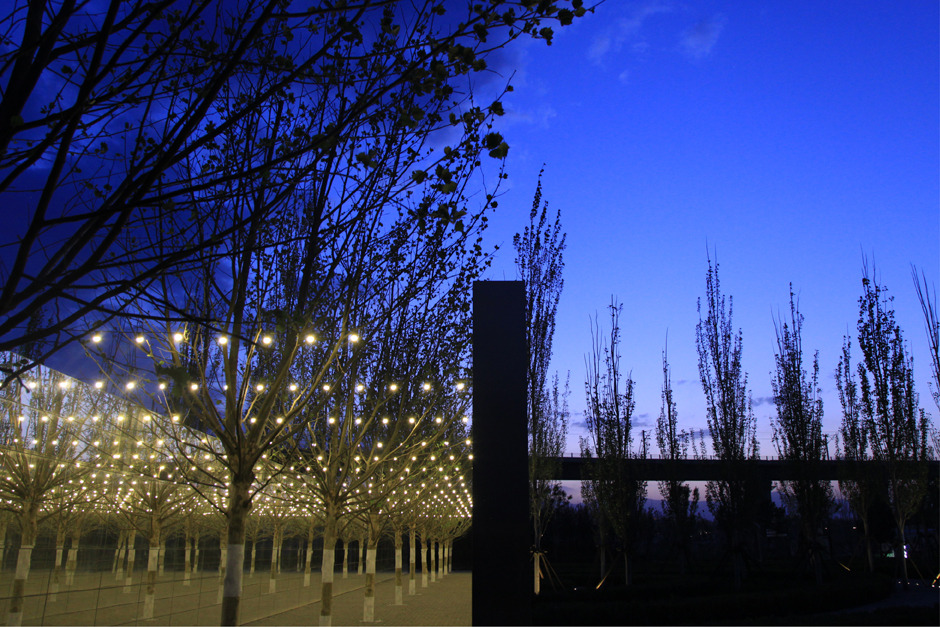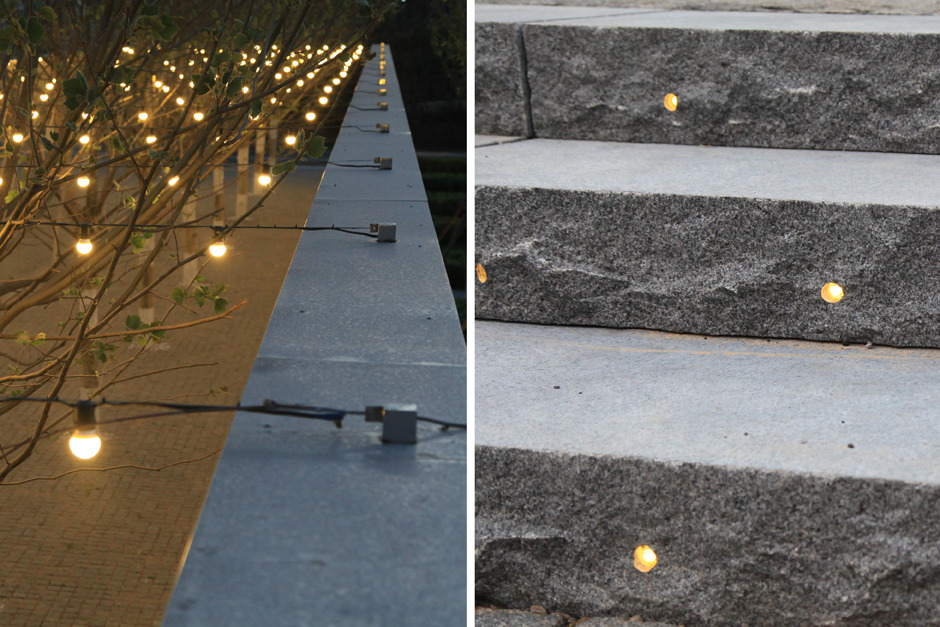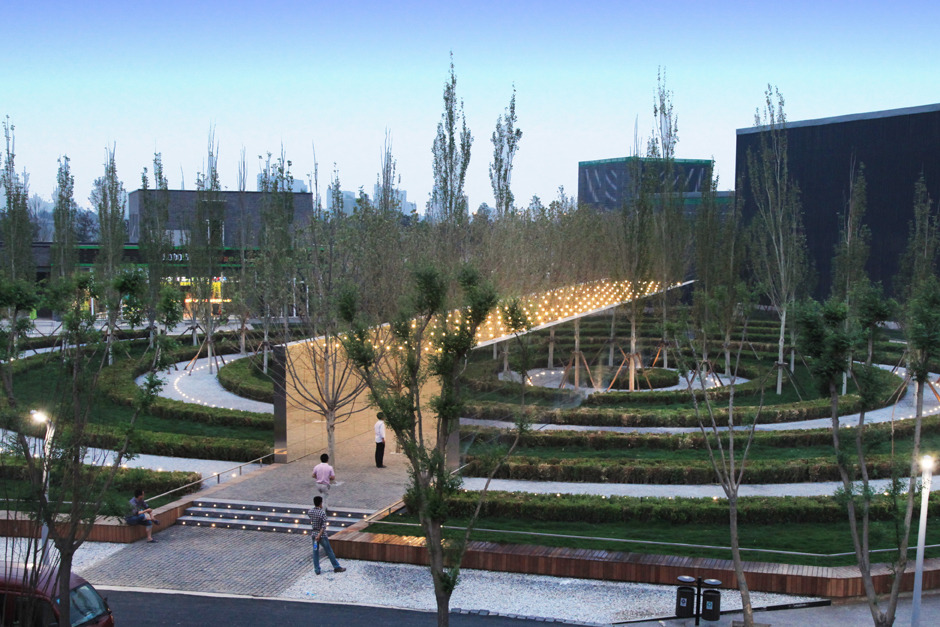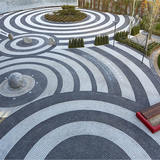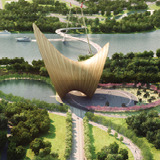
Finite/Infinite
Beijing
The garden is defined by one device that creates two contrasting conditions. A simple circular parterre garden is divided down the center by a pathway lined with two walls, each covered with mirrors on both sides. Centered in the central pathway is a line of sycamores on a five-meter grid.
For the viewer inside the two walls the pathway and its trees are transformed into an “infinite landscape” by the “barbershop effect,” in which reflections are reflected on top of reflections. The one row of sycamores becomes an orchard that multiplies into infinity. By contrast, the circular parterre is divided in half by the walls, until the viewer looks into the mirrors on the outside of the wall. . . and sees the parterre completed in its reflection. The mirrors on the outside of the walls thus create a defined, whole, and complete object.
Reflection is a phenomenon often used in landscape architecture, usually in some form of water—a pond, a river, a fountain. Glass shares many qualities with water, transparency, reflectivity and opacity—all apparent all the time at the same time. Typically water is associated with the landscape and glass with architecture.
Martha Schwartz’s garden for the 2011 Xian Horticultural Expo, for which BAM also played a key role, explored these reflective contrasts in landscape and architecture. The garden was a kind of maze—or fun house—composed of traditional Chinese wall typologies intertwined with glass and one-way mirrors. The adoption of the architectural method for achieving reflectivity and transparency in what was essentially a landscape condition prompted a further exploration in the Walker garden.
The completion of the circle in Finite/Infinite also recalls Walker’s early landscape experimentations, which were aimed at finding a minimalist expression for the landscape. For example, in the 1983 roof garden on Marlborough Street in Boston, the sky was reflected in small mirrors, typical of the modest materials used in these early experimental gardens. Finite/Infinite is at once more grand, more global, and more cerebral. The little mirrors of the Marlborough Street garden reflected little patches of sky; the mirrors of the Expo garden reflect the perceiving self of the viewer.
Artist Dan Graham has been famously quoted for stating the importance of the viewer who sees himself in the art work, for, of course, without the viewer the art would not exist. Not coincidentally much of Graham’s work uses glass and mirrors to allow the viewer to see not only himself but others in the action of viewing—and thus creating—the work of art.
Walker also found literary inspiration in Lewis Carroll’s Through the Looking Glass and What Alice Found There (1871), in which Alice tumbles through the parlor mirror to discover a new Alice in a thoroughly atypical garden of talking flowers. Inspired by these various sources, Walker explores new visions of garden reflectivity in Finite/Infinite.
In discussions with BAM, Walker expressed his interest in furthering Martha Schwartz’s exploration of reflection via mirrors and glass. Thus, when he came to Beijing to see the site, BAM presented him with a kit of elements: Mirrors, reflective paper, model trees, all were used in the work shop where Walker outlined the fundamentals of the design. BAM’s principle tasks were to turn Walker’s preliminary drawings and sketches into a constructible garden and then oversee its construction.
'Quality is everything.'
'God is in the details.'
'Measure twice, cut once.'
These terms are neither easily understood nor achieved when working in China. Unfortunately the design for this garden had very little tolerance for mistakes because everything in it was reflected. One mistake was not one mistake, but infinite mistakes. Thus there could be no mistakes. The garden could either be an abysmal failure or a great success, and it all was dependent upon the quality of the details—the craftsmanship—and, hence, on BAM’s unrelenting oversight of every step of the process. The details BAM developed are highly refined and required precision and care in the drawing, manufacturing, and installation. And not only are the hard details important. The quality of the planting and type of planting are key.
In Beijing there is a prejudice against poplars. Many landscape architects in China consider them low-quality trees, far too common for a show garden. Although the tree is found and was historically used in Beijing, this prejudice against using the common to create great value—and the tree’s frequent use in public projects—made it difficult to find the right trees for the garden. The pyramid white poplar or Xingjiang Poplar, which was specified, could not be found anywhere around Beijing or Hebei Province. This presented BAM with quite a problem because the garden required a columnar tree. Eventually we were able to find the right trees just West of Datong in Shanxi Provence, a place poor enough to appreciate the useful cultivation of cheap fast-growth trees. Happily the sycamore is considered a much more worthwhile tree. They fetch higher prices and are thus thought worth cultivating—and thus were easily acquired.
From the detailing, to the choice of plants, to the on-site supervision BAM was frequently a thorn in the side of both the client and the contractor because we chose to fight for the perfection of the design. We found it necessary to resist any compromises, especially ones based on offers of future work, and if that demand for perfection meant we had to go to the site and trim the trees ourselves, then we would. And we did. Although BAM had to be tough on the contractors, the Oriental Land team executed the design beautifully and professionally, and now all of us—designers, managers, and contractors alike—have a beacon that reveals to the world what landscape can achieve in China.
有限 / 无限
北京
在这个花园中,彼得•沃克以同一元素,在同一空间中创造出了两种截然不同的环境。花园被环形绿篱所覆盖,花园中央一条直线步道从圆环中央穿过,将花园一分为二,步道两侧各有一座双面镜墙,而步道中央以五米间隔均匀排布着一列悬铃木。
如此一来,对于步入镜墙内部的游人,由于倒影反射倒影的“理发店效应”,狭窄的步道空间瞬间扩大,成为一个“无限景象”:单排的悬铃木被不断复制成为一片无穷无尽的树林。而内部无限景象所对照,当游人处于镜墙外侧时,被墙体切割成半的绿篱又在镜面中与各自的倒影合并为完整的圆环,由此,一个清晰、完整的“有限景象”在镜墙外侧被创造出来。
倒影是风景园林中的常用手段,长久以来它都以水作为介质,存在与池塘、小溪、喷泉等形式中。玻璃与水具有共同的属性——透明与不透明、反射与折射,同生共存。在风景园林的实践中常以水作为材料,而在建筑领域则多采用玻璃。
玛莎•施瓦茨在2011年西安园艺博览会的大师园中曾尝试过镜像效果。玛莎的这个花园由一系列玻璃、单向镜子以及中式砖墙构成,它既是一个迷宫园林,同样也可以被看做是一个有趣的建筑,而玻璃与镜子这种常用的建筑材料则被用来营造充满反射与透明现象的景观效果。正是这一次尝试促使了沃克在今天他自己的花园里进行更进一步的探索。
在“有限/无限”花园中切割的半圆环被复原的现象其实来源与沃克早期的风景园林尝试,那时侯,他正致力于探寻园林风景园林中的极简手法。1983年,他在波士顿的屋顶花园中选用很多极普通的材料来进行实验性的创作,用来反射蓝天的小镜子就是其中一种。这些小镜子们像补丁一样反射出天空的颜色;而在“有限/无限”花园则反射出人们所能够感知的自我,相比之下后者的概念更加宏大、完整,也更加清晰。
正如艺术家丹•格雷汉姆广为流传的观点,如果没有观众,艺术将不复存在,让观众能够从作品中观察到自己,对于任何艺术作品都十分重要,因此格雷汉姆在众多作品中使用了玻璃和镜子,使人们在观赏的过程中不但能够看到自己,也能看到他人,从而创造出艺术作品的本身。
沃克也从文学作品中获取过灵感,比如著名的童话故事《镜子王国里的爱丽丝》,书中描写了爱丽丝穿过镜子来到镜子国里所遭遇的奇妙经历。源于众多启发,沃克一直想进行一次园林中关于光影反射的新尝试,而今天,终于有机会在北京完成了“有限/无限”。
项目之初,沃克在与BAM的沟通中表达出他对玛莎大师园中镜子、玻璃与光学反射的兴趣,以及进行进一步尝试的想法。随后沃克来到北京查看场地,在BAM的设计研讨中用镜子、镜面纸、模型树等材料制作实体模型,进行设计研讨,由此产生了花园的基本概念。 BAM的主要任务是将沃克的草图转化为一个能够被建造的花园,并负责监督整个施工过程。
Jake刚才所列举的“质量就是一切”、“上帝存在与细节”等等这些行业格言,在国内园林景观施工过程中常常被忽略。
而在这个花园里对于失误的容忍度又恰恰非常的小,因为所有的东西都会在镜面墙中被反射出来,任何一点施工错误——哪怕是一个非常小的失误——都将被无限倒映,成为巨大的败笔。可以说这个花园的最终效果,将在很大程度上取决于细节的工艺与质量,要么成功,要么失败品。正因如此,BAM坚持在每一个环节都细致地把控质量。在设计阶段,BAM深化的细部处理不仅需要制图过程中的精确与细致,也需要在工厂制做与现场安装阶段付出相同的努力。而且质量控制的重要性不仅仅存在于硬质景观的细节中,同样也依赖于植物材料的选择和运用。
在北京,人们对于杨树多少有所偏见,很多风景园林设计师都把杨树看做不太上档次的绿化材料,并不适合应用在展示型的精品花园里。尽管杨树在北京已有很长的栽植历史,但大多数都应用于道路及防护绿地等市政项目,业主与设计师往往都缺乏一种意识,那就是“用平凡材料创造高价值园林”,这个现象导致在我们在选择树种的时候遭遇了一些困难。我们的设计中需要竖直向上的柱状树形乔木,新疆杨是首选树种,但难以置信的是在北京甚至河北的所有苗圃里都未能找到理想的植株。最终在山西大同郊区找到了满足要求的杨树,或许是因为那里足够的贫瘠而保持了对这些廉价速生树种的需要,这个过程确实给我们带来了不小的麻烦。所幸我们选择的另一树种悬铃木相对要名贵一些,具有更高的种植价值,因此也更容易获得。
从硬景细部,到植物选择,再到现场配合与监督,BAM在业主与施工方眼中似乎始终都是一个麻烦的对象,因为在整个过程中我们始终拒绝妥协,力求完美。哪怕是需要我们亲自爬上树顶去剪枝,我们也会毫不犹豫。照片上可以看到,Jake就是这么做的。 在这个项目中,尽管BAM作为设计和监理异常的严格,但东方园林的施工团队非常专业地完成了任务,将Peter Walker精美的设计变为了现实。而这次实践成就了一个设计者、建设者和管理者三方紧密协作的成功案例,也向世界展示了在中国同样可以实现高质量的园林景观。

